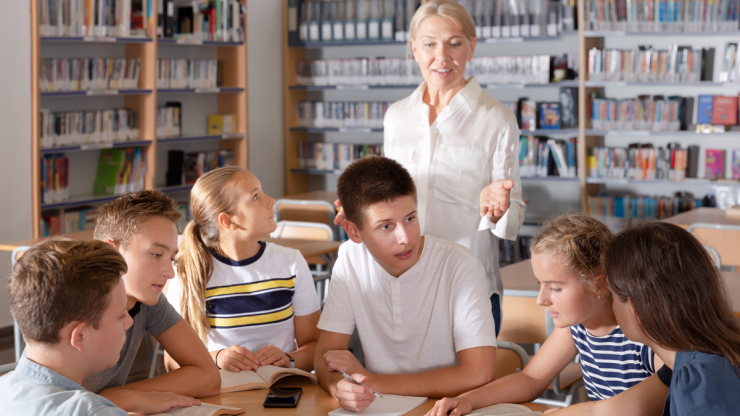The time spent in the classroom is used more for practice and knowledge consolidation. What exactly is new about this concept and how is it being applied in practice? Teachtoday spoke with German educator Sebastian Schmidt about this.

Flipped Classroom translates into German as inverted teaching. Roughly speaking, what you normally do in class is done in advance as homework. Then, in class, what normally causes the most difficulties is done: The practice, the consolidation, the transfer.
It gives you more time to open up the lessons in a student-centered and communicative way, for example. Explainer videos, for example on YouTube, are often a good way to prepare for the lesson. However, this is by no means the only option. I see not only preparation but also follow-up as essential in flipped classrooms. The things that students can easily do at home (small introduction, creating a notebook entry, solving a small task, discovering everyday life,) I shift to the preparatory or follow-up homework.
What the students usually find difficult, e.g. exercises, deepening, gritting their way through something, intensive cooperative discussion, I transfer to the classroom, because numerous helpers and above all I can support them there.
I came to this concept via the explanatory video. There are so many hacks, tips and tricks on YouTube for everyday life, that somehow had to be an improvement for the classroom as well. Cooking, assembling strollers, building a pool, tying a tie, ... then why not finally understand Pythagoras? I then created videos myself and tried to use them in the classroom. It took me a long time until I managed to do this in a way that made sense pedagogically and didactically. Above all, I realized that successful teaching requires more than just an explanatory video for preparation. It was only later that I learned about the concept of Flipped Classroom.
My first class was skeptical about this way of teaching. I had to promise them a four-week trial period. But at the end of it, no one wanted to go back to the old system. Since then, it's been a no-brainer; most students want to be taught according to this concept, even if not all of them get a better grade as a result. On the one hand, the personal responsibility and independence are perceived as a great opportunity, but not everyone is able to take advantage of this freedom. Above all, the classes I teach in this way appreciate learning with and via new media.
Their own teacher on YouTube, WLAN in the classroom, there are always new ways to make learning exciting, interesting and, above all, competent. Motivation is also a factor in giving this form of working a chance. Availability is also very important for most people: the teacher and the teaching materials are always in their pocket. Even the tenth time, Mr. Schmidt still explains it in a friendly manner.
At the beginning, it was completely new territory for me and I made many mistakes in developing this concept. It also involved a lot of convincing colleagues, principals, parents and, of course, the students themselves. However, one's own uncertainty coupled with critical questions allow one to reflect again and again on how something works and what one should leave alone. That alone develops the lessons further. If you get everyone on board and see yourself as a team in the learning process, it develops even more and shows everyone that lifelong learning in a team brings a lot of added value. Nevertheless, it remains a task. I don't think I have a ready-made learning concept, but one that works quite well.
It doesn't lead to less free time for my students. On the contrary: "We now have to do less at home and have more time to do our work in class," was one student's statement.
It's true, of course, in core subjects where there is traditionally homework. In other subjects, the flipped classroom may be more feasible to implement in an inclass flip. That means using digital (individual) materials in class, for example as a station in a learning circle. But I also use videos or preparatory introductions from time to time as homework in my minor subjects. Accordingly, in my opinion, forms of Flipped Classroom can be implemented in any subject.
The point is to open up the lessons in a student-centered way. In every subject, a teacher shows something once or has to guide something. You can outsource that to have more time for other things or so that students can simply look at a subject area as often as they need to.
I believe that digitization will change teaching and schools. But not to the point where everyone just sits in front of devices and does their work digitally. With digital learning materials, we can apply numerous new methods, teach in a more differentiated way and, above all, change our TEACHing activity in favor of a COACHing activity. At the same time, it is important to maintain proven pedagogical and didactic principles, to see the digital as an extension and not as a total replacement.
If you want to pick up today's kids, you need something more than just an overhead projector and a sheet of paper. At the same time, the main thing is to turn students into producers. Digital learning does not unfold through digital teaching materials. Students themselves must learn to engage with new media in order to participate in today's world and to be prepared for tomorrow's professional world. Therefore, our job as teachers is not becoming obsolete, it is just becoming more important in a different way. Those who continue to teach frontally may eventually be replaced by a robot or an algorithm. But if you see yourself as a learning companion, as a supporter, as a coach, as an educator at the side of young people, you can use digital tools to make your teaching sustainable and, above all, never be replaced.
The questions were asked by Martin Daßinnies.
 The importance of developing skills such as creativity and critical thinking is often stressed.
Knowledge or competence?
The importance of developing skills such as creativity and critical thinking is often stressed.
Knowledge or competence?
 Teachtoday inspires and encourages cross-disciplinary and project-oriented knowledge transfer.
Learning by trial and error
Teachtoday inspires and encourages cross-disciplinary and project-oriented knowledge transfer.
Learning by trial and error
The smartphone becomes a learning companion
Digital communication

